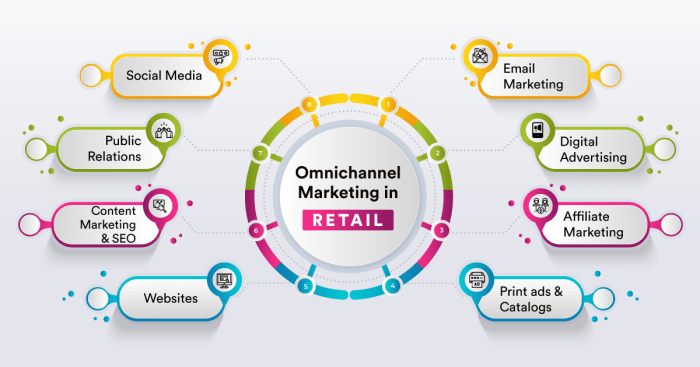Omnichannel Strategies Used by Top Retail Advertising Agencies: A Comprehensive Guide
Embark on a journey through the world of Omnichannel Strategies Used by Top Retail Advertising Agencies, where seamless integration and data analytics play a crucial role in crafting successful marketing campaigns.
Overview of Omnichannel Strategies
In the realm of retail advertising agencies, omnichannel strategies play a crucial role in reaching and engaging with customers across various platforms. These strategies involve creating a seamless and integrated experience for consumers, regardless of the channels they use to interact with a brand.
Key Components of Successful Omnichannel Strategies
Successful omnichannel strategies used by top retail advertising agencies typically consist of the following key components:
- Consistent Branding: Maintaining a consistent brand identity and messaging across all channels to ensure a cohesive customer experience.
- Data Integration: Utilizing customer data from different channels to personalize marketing efforts and tailor communication to individual preferences.
- Multi-Channel Presence: Establishing a presence on various platforms such as social media, websites, mobile apps, and physical stores to maximize reach and accessibility.
- Seamless Customer Journey: Creating a seamless transition for customers as they move between online and offline channels, ensuring a smooth and convenient shopping experience.
Importance of Integrating Various Channels Seamlessly
Integrating various channels seamlessly is essential for the effectiveness of marketing campaigns conducted by retail advertising agencies. By providing customers with a consistent and personalized experience across different touchpoints, agencies can build stronger relationships, increase brand loyalty, and ultimately drive sales.
This cohesive approach also allows for better tracking of customer interactions and behaviors, enabling agencies to optimize their strategies based on real-time data and insights.
Utilization of Data Analytics
Data analytics plays a crucial role in the omnichannel strategies of top retail advertising agencies. By leveraging data insights, these agencies can better understand customer behavior, preferences, and trends, allowing them to create more personalized and targeted campaigns across multiple channels.
Data Collection and Analysis Tools
- Customer Relationship Management (CRM) systems: CRM tools help agencies track customer interactions and collect valuable data on preferences, purchase history, and engagement metrics.
- Web Analytics platforms: Tools like Google Analytics provide insights into website traffic, user behavior, and conversion rates, helping agencies optimize their digital presence.
- Social Media Monitoring tools: Platforms such as Hootsuite or Sprout Social enable agencies to track social media mentions, engagement levels, and sentiment analysis to understand customer perceptions.
Interpretation and Personalization
Data analytics allows top retail advertising agencies to analyze customer data, segment audiences, and personalize marketing messages and offers based on individual preferences. By harnessing data from various touchpoints, agencies can create seamless and consistent experiences for customers across online and offline channels.
Personalization can range from targeted email campaigns to customized product recommendations on e-commerce websites, enhancing customer engagement and loyalty.
Customer Journey Mapping
Customer journey mapping is a crucial process in the realm of omnichannel strategies, as it involves visualizing and understanding the various touchpoints a customer interacts with throughout their purchasing journey. By mapping out these touchpoints, top retail advertising agencies can gain valuable insights into customer behavior, preferences, and pain points, enabling them to optimize engagement and enhance the overall shopping experience.
Process of Customer Journey Mapping
Customer journey mapping typically involves the following steps:
- Research: Agencies gather data on customer behavior, preferences, and interactions across different channels.
- Mapping: This data is then used to create a visual representation of the customer journey, detailing each touchpoint from awareness to post-purchase.
- Analysis: Agencies analyze the customer journey map to identify pain points, opportunities for improvement, and areas where engagement can be optimized.
- Optimization: Based on the insights gained, agencies implement strategies to enhance customer engagement and drive conversions.
Impact of Accurate Customer Journey Mapping
Accurate customer journey mapping can have a significant impact on conversion rates and brand loyalty. By understanding the various touchpoints and interactions that customers have with a brand, agencies can tailor their marketing efforts to meet customer needs at each stage of the journey.
This personalized approach not only increases conversion rates but also fosters brand loyalty and long-term customer relationships. Overall, comprehensive customer journey maps play a vital role in creating seamless and engaging omnichannel experiences for customers.
Seamless Integration of Online and Offline Channels

In today's omnichannel landscape, top retail advertising agencies are focused on ensuring a seamless integration between online and offline channels to provide a cohesive customer experience across all touchpoints.
Successful Campaign Examples
- One successful campaign that effectively bridged the gap between digital and physical touchpoints was by a leading fashion retailer. They launched an online marketing campaign promoting a limited edition collection, which drove customers to visit their physical stores to try on and purchase the items.
This integration not only increased online sales but also foot traffic in their brick-and-mortar locations.
- Another example comes from a major electronics retailer that utilized geolocation technology to target customers with personalized offers on their mobile devices when they were near a physical store. This seamless integration between online promotions and in-store shopping experiences resulted in a significant boost in sales and customer engagement.
Challenges and Opportunities
- One of the main challenges associated with integrating online and offline channels is maintaining consistency in branding and messaging across different platforms. Retail advertising agencies need to ensure that customers receive a unified brand experience whether they are shopping online or in-store.
- On the other hand, the integration of online and offline channels presents a significant opportunity for agencies to gather valuable data on customer behavior and preferences. By tracking customer interactions both online and in-store, agencies can create more targeted marketing campaigns and personalized experiences for their audience.
Wrap-Up
In conclusion, the effective utilization of data analytics, customer journey mapping, and seamless integration of online and offline channels are key aspects of successful omnichannel strategies. Dive deeper into this innovative approach to marketing and witness the transformation of customer engagement and brand loyalty.
Questions and Answers
How do top retail advertising agencies define omnichannel strategies?
Top agencies define omnichannel strategies as the seamless integration of various channels to create a unified and personalized customer experience across online and offline platforms.
What tools and technologies do top agencies use for data analytics in omnichannel strategies?
Top agencies utilize tools like Google Analytics, CRM software, and AI-driven analytics platforms to collect, analyze, and interpret data for personalized marketing campaigns.
Why is customer journey mapping important in omnichannel strategies?
Customer journey mapping helps top agencies optimize engagement by understanding customer touchpoints across different channels, leading to improved conversion rates and brand loyalty.
What challenges are associated with integrating online and offline channels in omnichannel strategies?
The main challenges include maintaining consistency in messaging across channels, tracking customer interactions seamlessly, and ensuring a cohesive brand experience both online and offline.



